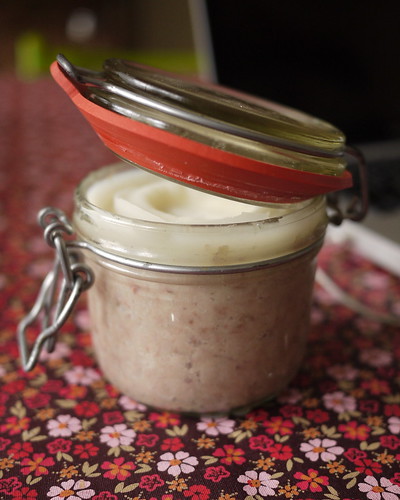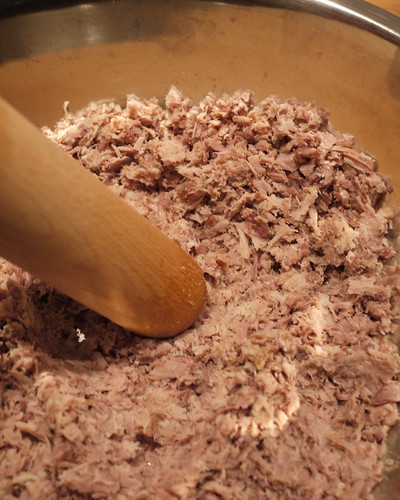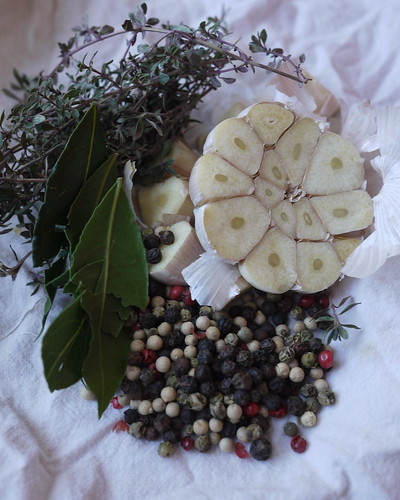
Nothing says love like potted pork. I haven't made rillettes in a while and I have forgotten how good they can be. I also had them in a restaurant a few months ago and I was reminded how bad they can be. The secret, don't chop them too long in the cuisinart lest they turn into what Jane Grigson describes as a "Porridge-like slush"

I pounded mine. But wait, this post is running like a Tarantino movie, I've started in the middle, now I've go to flash back to the beginning and work my way to the end.

I wrote about rilletes in this post from 2007. Like then, I made lard then slow cooked cubed pork in it. But here's what I did different:
Pre-salting. Nothing new here, Elizabeth David mentions it in her rillettes recipe, I salted at 2% of meat (i.e. 20g for 1000g of pork). I cut the pork into small chunks, salted it and let it sit overnight.
Slooow-cooking and not too long. 200F oven until the pork just falls apart. I did mine for four hours, and they were sightly overcooked. What's overcooked? Dry fluffy fibers that feel like sawdust on the tongue. But don't worry, adding back some melted fat will remedy the situation. Again I am getting to the end when I need to get back to the middle.

I melted about 1000g of lard for my 1000g of salted cubed pork shoulder. The pork should be completely under the lard. I added a sachet: A bulb of garlic, Handful of peppercorns, fresh bay and thyme tied in a muslin cloth. Place this in a 200F oven for 3 to 4 hours. Once done, drain and reserve lard, discard sachet, and allow the cubes of pork to rest for a half an hour. After resting, mince then pound the pork. While pounding add back some of the reserved lard, to achieve a nice pate. At this point you can add some seasoning, salt, quatre épices or some acid (lemon, wine). I didn't add any of these things, the pork stood on its own. Pack the rilletes into old jam jars or a crock, leave a little headroom then cover with a half an inch of melted lard. Store in the refrigerator, but allow to come to room temperature for service. Put the rillettes out with some pickled veg and grainy mustard. My German pal likes a little lard and rillettes spread on bread with a sprinkle of flaky salt. However you do it make it yours.

Cheers.
Further Reading:
Charcuterie and French Pork Cookery by Grigson
French Provincial Cooking by David
Pork & Sons by Reynaud
Charcuterie by Ruhlman and Polcyn
14 February, 2012
Rillettes Encore
17 December, 2007
Christmas Party


I love this roast. A boneless pork loin is wrapped with a pork belly. In between the layers a cream of olive oil, salt, rosemary, juniper berry, garlic and pepper is applied, then smoked over hickory.
Fazzoletti della nonna coi funghi secchi e spinaci.
 Italian crepes. I think it literally translates to "grandma's headscarf with wild mushrooms and spinach." I got the idea from Marcella Hazan.
Italian crepes. I think it literally translates to "grandma's headscarf with wild mushrooms and spinach." I got the idea from Marcella Hazan. I got these Criminis (baby bellas) River Valley Ranch in Burlington Wisconsin. Stop by if you are in the neighborhood.
I got these Criminis (baby bellas) River Valley Ranch in Burlington Wisconsin. Stop by if you are in the neighborhood. 
I made the mushrooms into a Duxelles, pureed sauteed spinach, and made a white sauce with Parmesan cheese. Making crepes was fun.

Rillettes du canard.
After receiving Brian's letter, The Jersey Report: Confit du Canard, I got a duck. I like to think I aways read the label but in this case I didn't and when I got home I realized that my pintail had been "flavored" with a brine solution. So I skipped salting it. Rillettes is potted meat, but to get the meat I have to make a confit first.


 I got about 12 ounces of fat from the duck. I needed more so I made some lard.
I got about 12 ounces of fat from the duck. I needed more so I made some lard.

Gravlax.

I feel no holiday is complete with out some home cured fish. This one with dill, white pepper and caraway.
Other Additions:
Kiff made a magical mango chutney to go with the pork. Audrey roasted chestnuts for a superb chestnut cheesecake. Corine's spinach salad added color and balance to the holiday fare. JJ made Christmas cookies, and Bonne Femme made her signature bacon and onion tart, polenta and the ever popular Ice box cake. Thanks everybody for a great party.

Merry Christmas
Cheers.
Posted by mac at 14:09 5 comments
Labels: confit, Curing Fish, duck, French Cooking, Gravlax, Holidays, Porchetta, Rillettes
24 October, 2007
Rillettes
Say you have a big Autumn sausage festival and you have some leftover ingredients. Ask yourself what would the French do? OK I am over generalizing again, What would a person of Angers, of Le Mans, or of Tours do? Why they would throw pork scraps into a big pot let it stew for a few hours then put it into jars to be used as sandwich spread. Stick a "gourmet" label on it and folks will snap it up at Dean & Delucca for twelve bucks a pop.
Rillettes is part of a family that includes Rillons and Rillauds (Tic loves the three R's). All three start out as Rillions which is cubed pork poached in fat. Rillauds are cured in salt prior to cooking. Rillons and Rillauds are served hot or cold soon after cooking. Rillettes are pounded (pesto!) after cooking then potted and covered with lard. Oh boy I'm getting hungry, let's get cooking.
Making Lard.First we need our cooking medium, lard. The hardest part of making lard is finding fresh pork fat. You can try asking at the grocery meat counter, but you'll have better luck if you go to a butcher or a packing house. Any kind of pork fat will do, it just needs to be fresh (it shouldn't have any unpleasant smell), and relatively free of meat.
Chop up the fat and put it into a pot. Place the pot uncovered into 250F oven for three hours, check it every once in a while, give it a stir, watch the fat melt away!
Once you have some nice brown bits and everything looks good and melted, strain of your hot lard.
As the lard cools to room temperature, it solidifies. Lard will keep in the fridge for a month or two before it starts tasting a little off. I have also read it keeps well in the freezer (just like butter huh?), but frankly there are so many things to do with lard (just wait until Christmas) that I usually use it up before I have to freeze it. Making lard is very simple and you get a product that is superior to what you can find in the store. That said, its okay to go to the store to get some, but the stuff sold in blocks at the grocery have hydrogenated fats and preservatives added and it really does not have much flavor. You would be better off to find a Hispanic market where you may find lard sold in tubs labeled Manteca. Wherever you go whatever you buy, always read the food label.

Rillettes.
The next day I melted the lard in a medium pan (sautoir) and added my cut up pork shoulder and a bouquet garni. The lard should just cover the pork. The pot goes in a 200F oven for several hours (maybe four) until the pork is fork tender. Strain while hot.

At this point it's time to add some spices and start pounding. Now you can start pounding with a mortar, maybe use a fork to pull apart the strands (I tried), or you can drop the the lot into a cuisinart set for obliterate (I did). While the blades where turning I added the juice of half a lemon and a bit of chopped parsley.
Les quatre épices: Poivre, macis, gingembre et clou. Un peu de sel.
Here's the portions I used:
For the Lard
517 g Pork Fat cubed (That's a little over a pound)
For the Rillettes
862 g pork shoulder cubed
Bouquet garni made up of fresh thyme, Hyssop, bay leaf and 2 cloves of garlic
10 g salt
7 g pepper
1 g mace
1 g ground clove
1 g ground ginger
Juice of half a lemon
a bit of parsely
For the fancy pants look, I put into a french jar and poured warmed lard to cover by about a half an inch.
Whatever.
Spread it on some bread crack it with some mustard and you got a fun snack. If you want to read more about Rillettes go to the library and look up Charcuterie and French Pork Cookery, by Jane Grigson, she has the word.
Put on some loud music and get back to work.
cheers.











